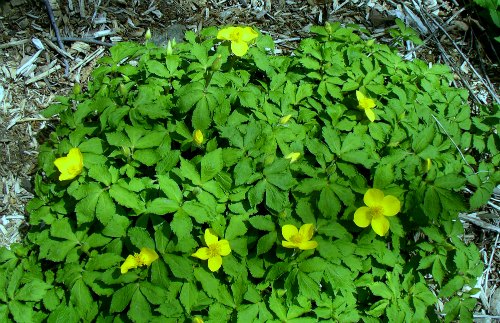Plant of the Month for June, 2015

(hy-LOH-mee-kon juh-PON-ih-kuh)
General Information:
Hylomecon japonica is a special, collectors plant for the shady garden. It is rarely offered for sale, and seed from most seed exchanges will provide the wrong seed. This is a plant that is certainly worth hunting down.

Hylomecon japonica; photo by Robert Pavlis
The plant forms quite large tubers that start to grow in early spring. In zone 5, the flowers appear early May and continue for about 2 weeks. When flowering is finished the plant has made a nice tight clump of leaves that persist until early summer. At that time the leaves die back, and the plant rests underground until next spring.
Common names for Hylomecon japonica include; forest poppy, Japanese woodland poppy, and Japanese poppy. These common names, and the yellow flowers have led to confusion in the industry. This plant is routinely confused with the other woodland poppies; Stylophorum diphyllum, Stylophorum lasiocarpum and Chelidonium majus.All four plants have similar looking leaves, and similar yellow flowers.
A detailed analysis of each of these species can be found at http://www.gardenmyths.com/hylomecon-japonica-which-is-the-real-plant/

Hylomecon japonica; photo by Robert Pavlis
S. lasiocarpum has leaves that are distinctly different and can easily be distinguished from the other 3. C. majus is a biennial and the flowers are half the size of the others. Hylomecon japonica and Stylophorum diphyllum can be easily distinguished by their seed pods. H. japonica seed pods are very thin and point straight up in the air. The seed pods of S. diphyllum hang down, and are plump fruits almost as wide as they are long. Once you understand that the 4 plants are similar, they are fairly easy to tell apart.
Hylomecon vernalis may be a different species, but some authorities consider it to be a synonym of H. japonica.
Life Cycle: perennial
Height: 30 cm (1 ft)
Bloom Time: spring
Natural Range: Japan, Korea, China and Russia
Habitat: forest understories, ditch sides, shaded habitats to 2400m
Synonyms: Chelidonium japonicum, Stylophorum japonicum,
Cultivation:
Light: part shade to shade
Soil: well drained to moist
Water: regular moisture in spring, dry after flowering
USDA Hardiness Zone: 5 – 9
Propagation: seed, division
Seedex availability (ORG&HPS annual Seed Exchange): occasionally
Germination is improved by using GA3. See http://botanicallyinclined.org/fridays-seeds-with-the-ga3-seeds-treatment
